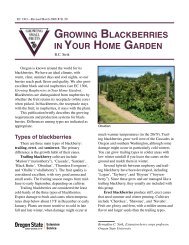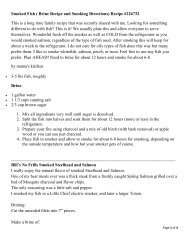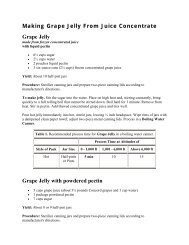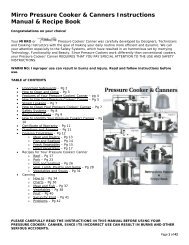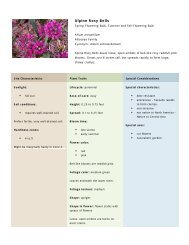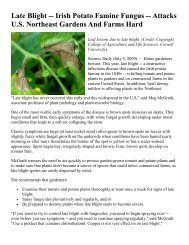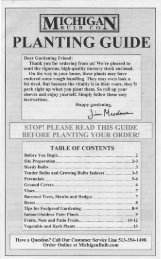Strawberry and Raspberry Pest Management in Wisconsin
Strawberry and Raspberry Pest Management in Wisconsin
Strawberry and Raspberry Pest Management in Wisconsin
You also want an ePaper? Increase the reach of your titles
YUMPU automatically turns print PDFs into web optimized ePapers that Google loves.
8<br />
Most labels also list a phone number that you (or medical personnel)<br />
can call for specific <strong>in</strong>formation on poison<strong>in</strong>g (or other accidents)<br />
<strong>in</strong>volv<strong>in</strong>g that particular product.<br />
PESTICIDE SAFETY Before you h<strong>and</strong>le pesticides, stop <strong>and</strong> read the label. Labels conta<strong>in</strong><br />
human safety precaution statements <strong>and</strong> list the specific personal<br />
protective cloth<strong>in</strong>g <strong>and</strong> equipment that you need to wear. Some of the<br />
follow<strong>in</strong>g may be label requirements; others are commonsense<br />
guidel<strong>in</strong>es that will help m<strong>in</strong>imize pesticide exposure to you, your<br />
coworkers, your family, <strong>and</strong> neighbors.<br />
• Wear a long-sleeved shirt, long trousers, shoes, <strong>and</strong> socks when<br />
h<strong>and</strong>l<strong>in</strong>g pesticides.<br />
• Wear coveralls (fabric or chemical-resistant) over your work clothes<br />
for an added layer of protection.<br />
• Unless the label states otherwise, always wear chemical-resistant<br />
gloves whenever you work with pesticides.<br />
• Wear chemical-resistant footwear, gloves, eyewear, <strong>and</strong> respirator (if<br />
the label requires one) when mix<strong>in</strong>g, load<strong>in</strong>g, or apply<strong>in</strong>g pesticides.<br />
• If you wear fabric coveralls, also wear a chemical-resistant apron<br />
when mix<strong>in</strong>g <strong>and</strong> load<strong>in</strong>g pesticides.<br />
• St<strong>and</strong> <strong>in</strong> the crossw<strong>in</strong>d when mix<strong>in</strong>g or load<strong>in</strong>g pesticides.<br />
• Never apply pesticides when there is the likelihood of significant<br />
drift.<br />
• Never leave a spray tank conta<strong>in</strong><strong>in</strong>g pesticide unattended.<br />
• Avoid back-siphon<strong>in</strong>g <strong>in</strong>to the water source.<br />
• Never eat, dr<strong>in</strong>k, or smoke when h<strong>and</strong>l<strong>in</strong>g pesticides.<br />
• Wash h<strong>and</strong>s thoroughly after h<strong>and</strong>l<strong>in</strong>g pesticides.<br />
• If you splash pesticide on yourself, remove contam<strong>in</strong>ated cloth<strong>in</strong>g<br />
immediately <strong>and</strong> wash yourself thoroughly.<br />
• Wash contam<strong>in</strong>ated clothes separately from other household<br />
laundry.<br />
• Keep pesticides <strong>in</strong> orig<strong>in</strong>al conta<strong>in</strong>ers.<br />
• Store <strong>and</strong> lock pesticides out of the reach of children.<br />
• Observe restricted entry <strong>in</strong>tervals on a treated crop or area.<br />
PESTICIDE ACCIDENTS <strong>Pest</strong>icide spills. Regardless of the magnitude of a spill, the objectives of<br />
a proper response are the same—you must control the spill, you must<br />
conta<strong>in</strong> it, <strong>and</strong> you must clean it up. A thorough knowledge of<br />
appropriate procedures will allow you to m<strong>in</strong>imize the potential for<br />
adverse effects.<br />
Spills of any compound need to be reported to the WDNR. However,<br />
you do NOT need to report the spill if it is completely conf<strong>in</strong>ed with<strong>in</strong><br />
an impervious secondary conta<strong>in</strong>ment, <strong>and</strong> the spilled amount can be<br />
recovered with no discharge to the environment. On the other h<strong>and</strong>, a<br />
spill of any amount is reportable if it occurred outside of secondary<br />
conta<strong>in</strong>ment <strong>and</strong> it caused, or threatens to cause, adverse effects on<br />
human health or the environment (e.g., back siphon<strong>in</strong>g). The spill is<br />
exempt from the WDNR report<strong>in</strong>g requirements if you deem the spill<br />
will not cause, or threaten to cause, such adverse effects, <strong>and</strong> the<br />
amount spilled would cover less than 1 acre if applied at labeled rates<br />
<strong>and</strong>, if a SARA pesticide, is less than the reportable quantity.




